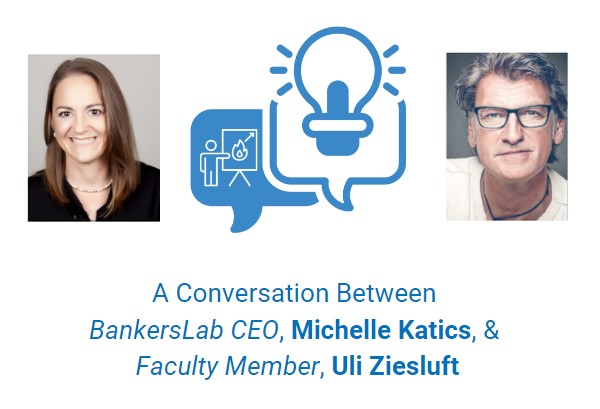Data Storytelling has emerged as a ‘hot topic’ for skill development in the financial industry. Why? What outcomes need to change?
BankersLab CEO Michelle Katics sits down with BankersLab Faculty Member Uli Zeisluft to find out more. Uli taught a number of Data Storytelling courses in 2020 over VILT (Virtual Instructor-Led Training) format and drove lively collaboration and creation over Zoom, Webex, and Teams – around the world.

Michelle: Uli, why is Data Storytelling so popular right now?
Uli: When I was first introduced to the concept of data storytelling, I was intrigued, but I also didn’t really know what I was going to get into or how audiences would respond to it.
The name “Data Storytelling” is almost refreshingly misleading because in the lending space, we’re not there to be telling stories, we’re there to be managing portfolios – but the truth is through stories we are better able to understand the data and what actions to take.
When you think about storytelling, you think of a parent reading to a child as they put it to bed. If you look at it closely, the parent is not just telling a story but is actually creating memorable history by making the words come to life.
In our professional careers, we’ve all learned to present data but we don’t give much thought to HOW we tell these stories. We haven’t been taught how to embrace the beauty of telling a good story.
Michelle: The first bank that asked us for our Data Storytelling course was frustrated because they’d been storing so much data, but they felt they weren’t getting value from it for themselves or their customers.
They told us, “We’re swimming in a lake of data and don’t have a drop [of insights] to drink.”
Uli: You have a ridiculously large amount of data and information, and most people feel like they have to present most of it.
However, the true power lies in being able to create a simple visualization of the underlying data and to turn this into a crisp, compelling, and captivating story that enables the audience to turn the information presented to them into informed decisions.
Unlearning can be more difficult than learning. One of our clients explained they felt a big part of data storytelling is unlearning bad habits. Do you think this is true? IF so, what are those bad habits?
Uli: I have a sense that there are a number of people sitting in our workshops who realize, “jeepers, I’ve been doing this all wrong!”
So, they have to unlearn things and unlearning anything is not trivial. Realizing that you need to take a different approach is tough, because it takes character and humility to admit to yourself that you have to learn to refocus first. There’s so much comfort in the simplicity of the repetition, even if you weren’t using the best data practices to get the most out of your data.
If you’re being asked to find that gold – to find the data hero – to sift through all the data gunk to finally find something precious. This is what we try to enable.
You’re essentially putting something on just one page that would have taken dozens of pages or tables before. Although, some people are reluctant at first, generally they are very excited about the idea of learning how to create this one simple page or single slide that speaks for itself.
What type of business impact do you think we should see from successful data storytelling?
Uli: Data storytelling is all about finding that insight that really pops out for you and is truly relevant for your audience. If you’re not a good storyteller, you’re going to lose your audience.
You want a story to capture the listeners’ attention, to really trigger their imagination.
The important thing is that the business impact comes from creating a story that you can actually do something with.
What is the most difficult part of teaching this subject? The most satisfying?
Uli: Actually, it is not that difficult. However, it takes a little bit of practice to learn how to present something potentially complex in an unadorned fashion. It follows the beautifully simple concept: less is more.
Show me a manager who doesn’t already spend a significant number of hours in tools like Excel, creating a lot of reports, and – hopefully – occasionally getting the opportunity to present these.
And while the visual capacities of these tools are getting much more sophisticated, the people using them haven’t been keeping up with where the trend is going, to be honest. We’ve just been accumulating data without having a clear purpose or methodology in mind before churning out these reports.
In terms of the most satisfying, I have to say that it is so rewarding when I witness how our attendees start to embrace this new concept after it has sunk in how powerful it is.
I also really enjoy it when participants bring in one of their typical data reports, and then take a stab at improving it by applying their newly gained skills; it’s amazing to see how some end up with very impressive results.

We hear that participants just LOVE these courses. Why do you think that is?
Uli: We’re naturally drawn to stories because they’re so relatable. Over the course of the workshop participants learn how to maintain the audience’s attention by being specific and relevant. This is achieved by understanding the experience of their audience, and by speaking to their pain points.
We teach the practice of keeping it simple. It’s tempting to get fancy, but the more simplistic these stories are, the more powerful they are by just boiling things down to the essentials.
Are there any broader industry trends that you think are driving the popularity of this course?
Uli: The real question is, “How do we let data tell us the story that helps us make better decisions for the future of the organization?”
Data visualization has been around for a while as a small niche, but now it’s critical for all industries, not just for finance and lending. Taking an abundance of data and presenting it in a meaningful fashion.
Data is really everywhere today. Just think of a newspaper like USA Today which has many cool infographics, yet many banks have an army of data scientists who may not be able to clearly explain what’s in their lending portfolio!
Uli: It’s cool that we have seen the adoption of all of this data visualization and infographics; this has helped raise people’s expectations, which is awesome, but then you go into a bank and they’re wondering, “how come we don’t have it here?”
Just think about some of the big events of the last year; the elections in the United States in terms of voter trends or the COVID-19 infection rates and death rates.
We could marvel at the power of those nearly instant and highly accurate visualizations that speak for themselves. But then you go to a department meeting at a bank where all they have is pages of bar charts and you just wonder, “Is this the best we can do?”
What is the most surprising element for participants of the process (DIAO & the Data Hero)?
Uli: That DIAO process (Data, Insight, Action, Outcome) to discover the underlying information which allows you to state the hypothesis you want to prove. You have to adopt this process very carefully and to understand what is that single information element that’s most essential: that’s what we call the “data hero”.
The goal of the data story is to facilitate an action that then leads to a positive, meaningful outcome for the organization at the portfolio level or even better at the institutional level.
Michelle: Knowing what to do with the data and then knowing how this should influence my actions, is this the real pain point?
Uli: The actionability is key. Take for example the underwriting process and how all the data turns into simple accept and reject decisions. It’s the same here with how we use and interpret big data, we’re taking something complex and turning it into something very simple that can easily be the basis for action.
Any other concluding thoughts?
Uli: We are a species that thinks in and recognizes patterns; it’s what kept our ancestors alive in ancient times, learning and observing what could help and harm us. Our eyes have the ability for panoramic vision, but can also zoom in and focus on what is fundamentally important and therefore requires our undivided attention.
In a major way, pattern recognition has gotten us where we are today.
Today, this means turning these skills into creating meaningful data visualizations that inform our decisions. That’s what we do in data storytelling.

Michelle: Gone are the days with long PowerPoint decks. It sounds like now — every graph title needs to already have a clear interpretation.
Uli: It’s funny, there’s an exponential increase in the amount of data on the planet.
But we’re getting lost in all this data! We’re spending and investing all this human capital and money to understand our customers better and better. But if we don’t use that data properly we end up upsetting our customers – and losing the opportunity to delight them.
Data is a double-edged sword: if you don’t distill the relevant information and extract the right story to drive high-quality decisions we risk that a lot of customers will be unhappy; but do it well and anything is possible.




